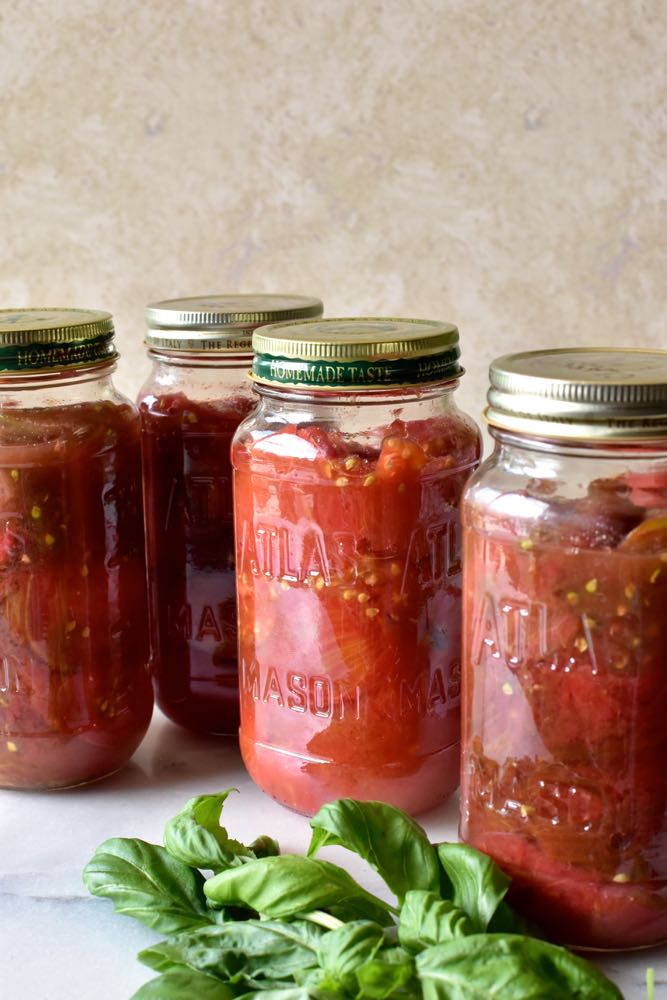Our vegetable garden is producing an abundance of tomatoes this year, and we couldn’t be happier! I’ve made many dishes with them, and gallons of gazpacho. But at this point, I want to be able to enjoy our organically grown tomatoes in the winter months.
There are many ways to preserve tomatoes, including freezing them. My favorite is to can them (more specifically I “jar” them). It’s an easy process that may seem difficult only because of the time it takes. But in reality, a good part of it is inactive time, so you can dedicate yourself to other tasks while the tomatoes are being processed (be nearby, though). The result is organic tomatoes in the off-season! That’s really worth it.

Some notes and recommendations:
- Roma tomatoes might be the best variety to can, as they have a lower water content. You can can any other kinds of tomatoes (like I did), but the end result will be jars where the tomatoes tend to move to the top and there’s a small amount of water at the bottom. That’s perfectly fine and it’s only an aesthetic issue: just shake the jars gently before using
- Tomatoes have to be blemish free. Use the best and freshest tomatoes possible
- When canning tomatoes, you have to follow some safety rules to avoid contamination by bacteria, yeast and molds. That’s why the boiling times are so important, as well as the acid level. Canning jars and lids also have to be sterilized. But don’t be discouraged: it’s a pretty easy process.
USDA guidelines for canning tomatoes:
- It is important that the pH inside the preserved jars is lower than 4.6 to avoid the growth of the botulism toxin. Tomatoes vary in acidity, therefore it is important to add extra acid for extra safety. Add 2 tablespoons of bottled lemon juice per quart of tomatoes, or 1 tablespoon per pint. The acid can be added directly to the jars before filling them with the tomatoes. Bottled lemon juice has a more constant acidity level than freshly squeezed lemon juice, and therefore it is preferred.
- Boiling temperatures vary depending on altitude and the food to can. In my area, and for tomatoes, the recommended boiling time is 40 minutes per pint or 50 minutes per quart.
For more detailed information on USDA recommendations for canning tomatoes, click here
For boiling times depending on the altitude, click here.

















METHOD
Utensils:
- Large stock pot
- Jars and lids (I used 1 pint mason jars)
Ingredients:
- Tomatoes
- Bottled lemon juice
- An average of 14 Lbs of fresh tomatoes is needed to can 9 pints. The amount of fresh tomatoes I had allowed me to fill up 5 pints
Prepare the jars and lids:
- Fill with water a large and deep enough pot to hold the jars standing up
- Immerse the jars and bring to a boil (fill them up with some of the water so they sumerge). Boil the jars for 10 minutes. Carefully remove from the pot and let dry
- Now immerse the lids in the water and boil for 10 minutes. Remove carefully and let dry
Prepare the tomatoes:
- Wash and score the tomatoes by cutting a superficial cross at the bottom of each tomato
- Prepare an icewater bath in a bowl large enough to hold the tomatoes
- Place the tomatoes in the boiling water for about 60 seconds. Remove from the hot water and quickly place them in the icewater bath. This loosens the skins from the flesh. Peel and discard the skins
Process:
- Pour 1 tablespoon bottled lemon juice in each jar
- Fill up the jars to the top, slightly pressing the tomatoes, and leaving about 1/2 Inch of space at the top (you can cut the tomatoes in chunks if they are too large)
- Wipe the rims of the jars and screw the lids until tight
- Place the jars in the pot with hot water, making sure they are covered at least 1 to 2 inches above the top of the jars
- Bring the water to a rolling boil and start the timing process. Processing time depends on the altitude, and in my case, I processed for 50 minutes
- Carefully and safely remove the jars from the hot water an allow them to cool down before storing









